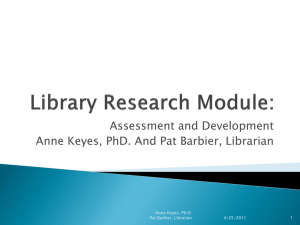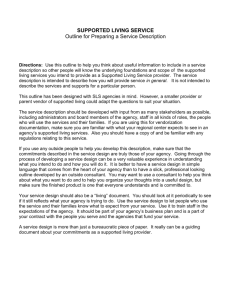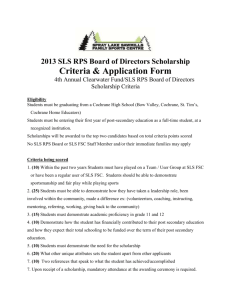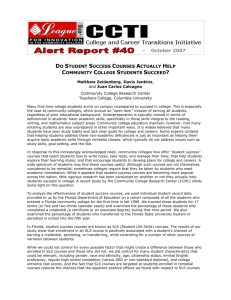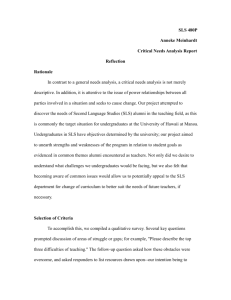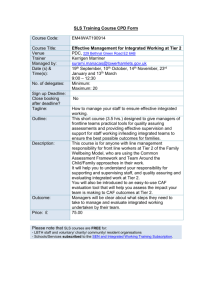CLICK Here to see our history
advertisement
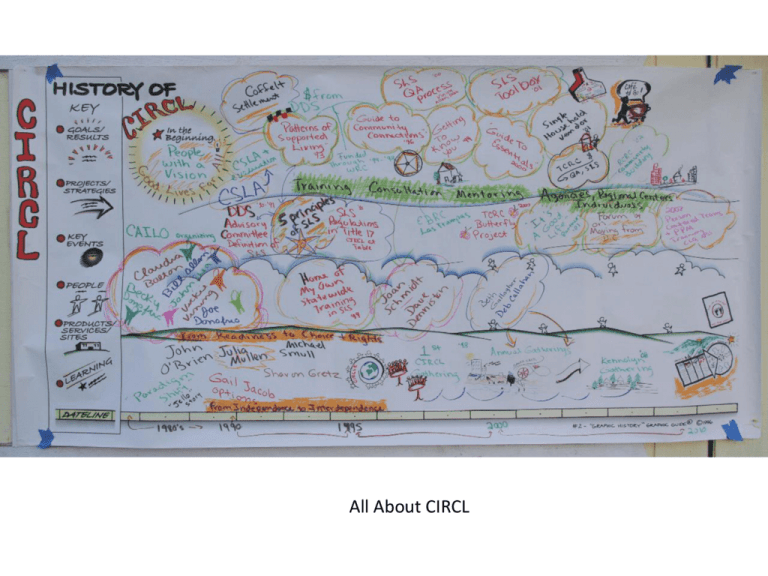
All About CIRCL 1970’s-1980’s In The Beginning There Were People with a Vision And the openess to seek out Mentors CIRCL has always been about: - Gatherings - Focus Groups - Shared Learning - Deep thinking together - Thinking about what could be Influenced by John O’Brien, Marsha Forrest, Judith Snow, Jack Pierpoint, Michael Smull, Bill Allen and John Shea Premise is that: - All the knowledge is in the room - All the right people are here We create an atmosphere of respect and listening and learning World Café Hospitality Open Space Annual “Gatherings” in Santa Cruz Since 1998 Early Gathering Early Gathering Entry Boards and Agency Introductions Creating Hospitality Hostesses Gathering 2010 Open Space - 2003 CIRCL Gathering 2002 2006 Patterns of Supported Living A Resource Catalogue Developed for: California Department of Developmental Services 1600 9th Street Sacramento, CA 95814 D.D.S. Contract No. Hd290099 by: Allen, Shea & Associates 1040 Main Street, Suite 200B Napa, CA 94559 and Claudia Bolton Forrest 6/93 A conceptual revolution (Schwartz, 1992) is occurring in the way people with disabilities are perceived and the ways in which they are supported. People with disabilities have been teaching us that they have unique gifts to offer and that we need to listen to them to figure out how to support them. People in the social service professions are starting to recognize that building effective services starts with building relationships with people who have disabilities. A shift from the traditional isolation and segregation of the residential service system to supported living services is just one indicator of the conceptual revolution. Page 9 in Patterns.. The California Department of Developmental Services' Supported Living Advisory Committee (1991), recommended the following definition: Supported living services are an array of services that are available to anyone who desires (or whose family, advocate, or conservator desires for her or him when someone cannot express their own choice) facilitation, instruction, support, and assistance to live in the home of his or her choice. Pages 15 and 16 in Patterns… Supportive Living Services Include, But are Not Limited to . . (California Department of Developmental Services, 1992) financial management check cashing purchasing activities budgeting and bill paying correspondence with official agencies meal preparation cooking shopping menu planning personal health and hygiene home and community safety general household activities household care and maintenance activities essential to health eating, bathing, dressing, grooming, assistance with the medical care of children assistance with the recruitment, screening, obtaining police, fire, or emergency help hiring & supervision of personal attendants community resource awareness and assistance orientation to the community identification of and access to points of interest mobility training care and repair of durable medical equipment access to leisure activities use of leisure time cultivating and maintaining friendship participation in community recreation interpersonal communication skills adaptive social skills self-advocacy support for marital and sexual relationships parenting skills 24-hour emergency assistance services training in the selection and use of crafting of unique technology and equipment assistive technology & adaptive equipment communication devices repair & maintenance of assistive technology home modifications vehicle modification canine and other animal companions interpreters or translators securing suitable housing facilitating circles of support………………………….Page 18 in Patterns… California Code of Regulations Title 17, Division 2 Chapter 3 - Community Services SubChapter 19 - Supported Living Service Article 2 - General Provisions §58614. Service and Support Components. (a) Supported Living Service, as referenced in Title 17, Section 54349 (a) through (e), shall consist of any individually designed service or assessment of the need for service, which assists an individual consumer to: (1) Live in his or her own home, with support available as often and for as long as it is needed; (2) Make fundamental life decisions, while also supporting and facilitating the consumer in dealing with the consequences of those decisions; building critical and durable relationships with other individuals; choosing where and with whom to live; and controlling the character and appearance of the environment within their home. (b) Supported Living Service(s) are tailored to meet the consumer's evolving needs and preferences for support without having to move from the home of their choice, and include but are not limited to the following: (1) Assisting with common daily living activities such as meal preparation, including planning, shopping, cooking, and storage activities; (2) Performing routine household activities aimed at maintaining a clean and safe home; (3) Locating and scheduling appropriate medical services; (4) Acquiring, using, and caring for canine and other animal companions specifically trained to provide assistance; (5) Selecting and moving into a home; (6) Locating and choosing suitable house mates; (7) Acquiring household furnishings; (8) Settling disputes with landlords; (9) Becoming aware of and effectively using the transportation, police, fire, and emergency help available in the community to the general public; (10) Managing personal financial affairs; (11) Recruiting, screening, hiring, training, supervising, and dismissing personal attendants; (12) Dealing with and responding appropriately to governmental agencies and personnel; (13) Asserting civil and statutory rights through self-advocacy; (14) Building and maintaining interpersonal relationships, including a Circle of Support; (15) Participating in community life; and (16) 24-hour emergency assistance, including direct service in response to calls for assistance. This service also includes assisting and facilitating the consumer's efforts to acquire, use, California Code of Regulations Title 17, Division 2 Chapter 3 - Community Services SubChapter 19 - Supported Living Service Article 3 - Consumer Rights §58620. Consumer Preferences and Leadership. Consumers receiving SLS shall have the right to make decisions that shape the nature and quality of their lives in accordance with their preferences, and consistent with the goals of the consumer's IPP. These rights shall include, but are not limited to, the following: (a) Choosing where and with whom to live; (b) Controlling the character and appearance of the environment within their home; (c) Choosing and changing their SLS vendors and direct service staff; (d) Participating actively in their IPP process so that the SLS they receive is based on their needs and preferences; (e) Receiving services appropriate to their evolving needs and preferences for support without having to move from the home of their choice, for as long as SLS remains the preferred objective, as determined in the consumer's IPP process; and (f) Informing the regional center about how satisfied they are with the services they are receiving, and to have this information taken into account in the regional center's periodic evaluation of the SLS vendor's service, pursuant to Section 58671 (c). California Code of Regulations Title 17, Division 2 Chapter 3 - Community Services SubChapter 19 - Supported Living Service Article 2 - General Provisions §58613. Consumer Eligibility Determination. (a) A consumer shall be eligible for SLS upon a determination made through the IPP process that the consumer: (1) Is at least 18 years of age; (2) Has expressed directly or through the consumer's personal advocate, as appropriate, a preference for: (A) SLS among the options proposed during the IPP process; and (B) Living in a home that is not the place of residence of a parent or conservator of the consumer. (b) Consumers shall not be denied eligibility for SLS solely because of the nature and severity of their disabilities. Rights of Individuals Receiving Supported Living Services The Lanterman Act and the SLS regulations state that individuals receiving SLS shall have the right to make decisions that shape the nature and quality of their lives. Individuals in SLS have the following rights: To choose where they live. To choose who they live with, if anyone. To control the environment (character and appearance) within their own home. To receive services and supports that change as their needs change without having to move elsewhere. To choose and change their SLS vendors and direct service staff. To receive services based on their needs and preferences. To receive services and supports that assist them to exercise choice in his or her life while building critical and durable relationships with other individuals. Supported Living Principles • • • • • A Home of One’s Own Choice and Self Direction Relationships Community Membership Flexible, Tailored Services and Supports “Taking a direct, frontal approach to changing values is fraught with difficulty, resistance, and strong human emotion. We therefore start with behavior instead. We start with the behavior that will lead to the desired change in attitudes and values.” W. Warner Burke, Organization Change p. 13 Tip: Principles Can Guide the Behavior That Can Lead to Changes in Attitudes and Values Who wrote the Principles? Where did they come from? First published by CIRCL in 1999 but.. The Principles were gleaned from the SLS regulations, CIRCL, and the work of the SLS Evaluation Group, Allen, Shea & Associates, Service Reform Committee, Jay Klein, John O’Brien, and Julia Mullen and her staff This is Important To Remember!!! 2007 Beth Gallagher sometime in the earl


